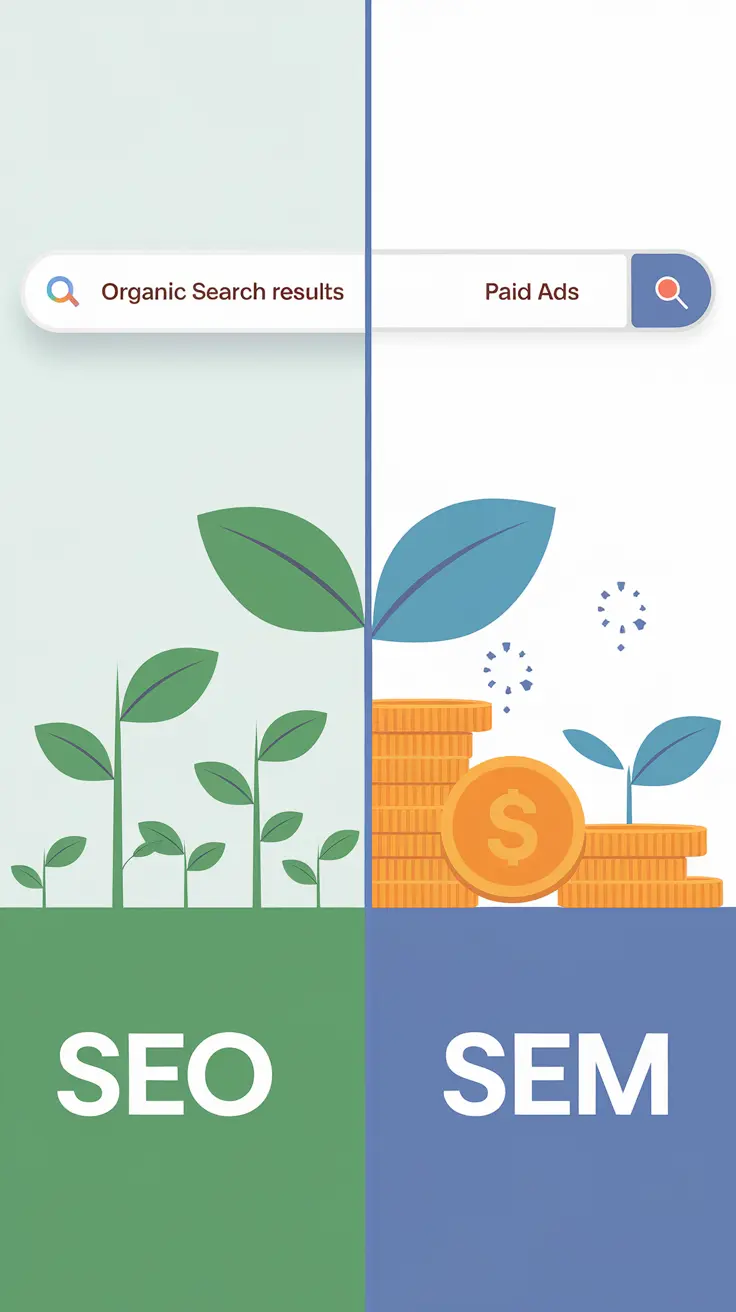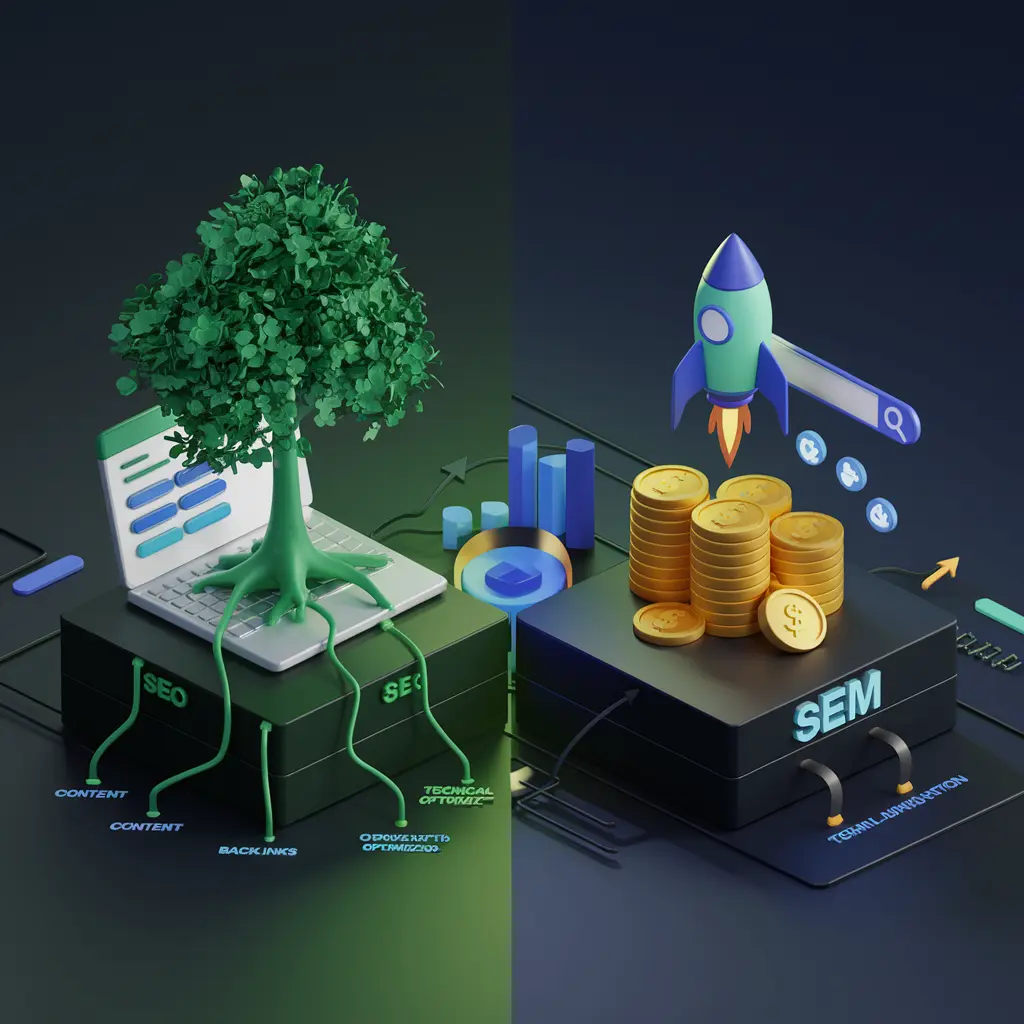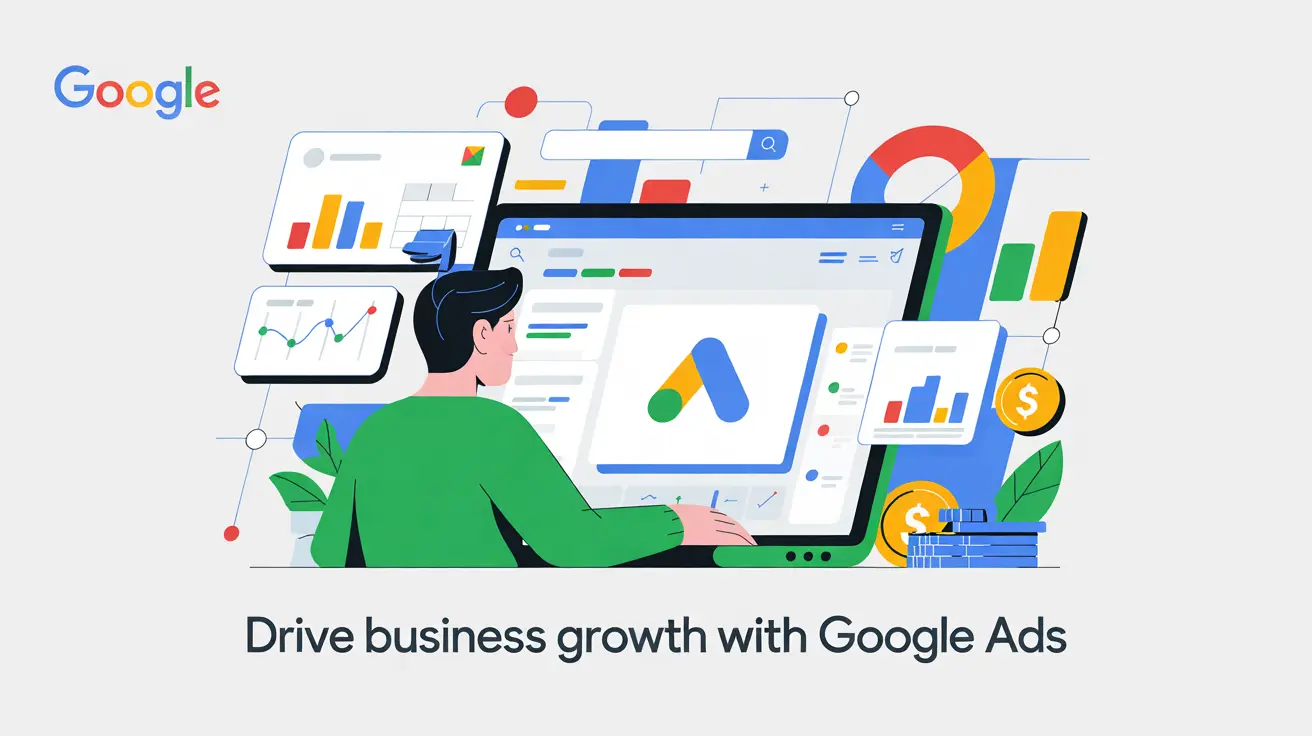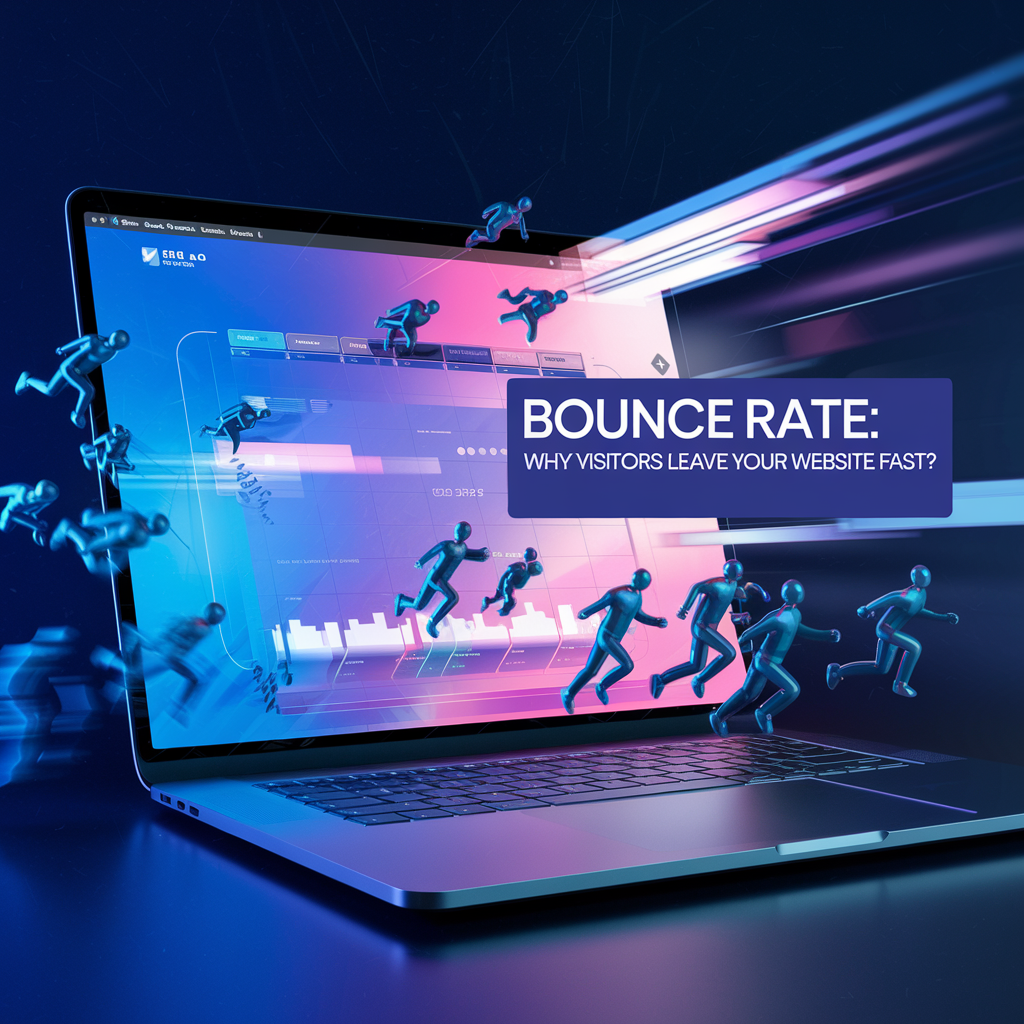SEO Versus SEM, has always been an unclear myth in online marketing. Are you struggling to decide between
SEO and
SEM for your digital marketing strategy? You’re not alone! In today’s competitive online landscape,
choosing the right approach to boost your visibility can feel like navigating a maze. But don’t worry, we’re here to help you find your way.
At our agency, we’ve seen countless businesses grapple with this dilemma. Should they focus on organic
search engine optimization (SEO) or invest in paid
search engine marketing (SEM)? The truth is, both strategies have their merits and pitfalls. That’s why we’ve created this comprehensive guide to help you understand the
key differences between SEO and SEM, and how to leverage them for your business success. in the UAE or anywhere else in the world.

In this blog post, we’ll dive deep into the world of digital marketing, exploring how to grow your online visibility, comparing the main features of SEO and SEM, and discussing the timeline for results and cost implications. By the end, you’ll have a clear understanding of whether to focus on SEO, PPC, or a combination of both. Let’s embark on this journey to boost your online presence and drive real results!
Grow your online visibility.
Understanding Online Visibility
In today’s digital landscape, growing our online visibility is crucial for business success. We need to understand that online visibility refers to how easily potential customers can find our brand or website on the internet. It’s not just about being present; it’s about being prominently visible when our target audience is searching for products or services we offer.
Strategies for Increasing Visibility
To enhance our online presence, we can employ several effective strategies:
- Content Marketing
- Social Media Engagement
- Search Engine Optimization (SEO)
- Pay-Per-Click Advertising (PPC)
Let’s take a closer look at how these strategies compare:
| Strategy |
Organic/Paid |
Time to Results |
Cost |
| Content Marketing |
Organic |
Long-term |
Low to Medium |
| Social Media |
Both |
Short to Medium |
Low to High |
| SEO |
Organic |
Long-term |
Medium to High |
| PPC |
Paid |
Immediate |
High |
The Role of SEO and SEM
When discussing online visibility, we can’t ignore the importance of SEO and SEM. These two approaches form the cornerstone of many successful digital marketing strategies:
- SEO (Search Engine Optimization): We focus on optimizing our website and content to rank higher in organic search results.
- SEM (Search Engine Marketing): This broader term encompasses both SEO and paid advertising strategies like PPC.
By understanding and implementing both SEO and SEM techniques, we can significantly boost our online visibility and reach our target audience more effectively. In the following sections, we’ll delve deeper into the specifics of SEO and SEM, comparing their features, timelines, and costs.
SEO vs SEM: Main Features
 SEO Overview
SEO Overview
SEO, or Search Engine Optimization, is a crucial component of digital marketing that focuses on improving a website’s organic visibility in search engine results. Here are the main features of SEO:
- On-page optimization: This involves optimizing individual web pages to rank higher in search results.
- Off-page optimization: This refers to actions taken outside of your website to improve its search engine rankings.
- Technical SEO: This ensures that search engines can crawl and index your site effectively.
| SEO Component |
Description |
Examples |
| On-page |
Content and HTML source code optimization |
Keyword optimization, meta tags, header tags |
| Off-page |
External factors influencing rankings |
Backlinks, social media signals |
| Technical |
Website and server optimizations |
Site speed, mobile-friendliness, SSL certificate |
SEM Overview
SEM, or Search Engine Marketing, encompasses a broader range of strategies, including paid advertising, to increase visibility in search engine results pages (SERPs). The main features of SEM include:
- Paid search advertising (PPC)
- Display advertising
- Remarketing campaigns
SEM offers more immediate results compared to SEO but requires ongoing investment. It allows for precise targeting and quick testing of different strategies.
Now that we’ve covered the main features of SEO and SEM, let’s explore how long it typically takes to see results from each approach.
SEO vs. SEM: How Long It Takes to See Results
SEO: A Long-Term Investment
When it comes to SEO, patience is key. We typically see results from our SEO efforts within 4-6 months, but it’s important to note that significant improvements often take 6-12 months or more. This timeline can vary depending on factors such as:
- Website age and authority
- Competition in your industry
- Quality and consistency of content
- Technical optimization of your site

SEM: Quick but Temporary Results
In contrast, SEM delivers almost immediate results. We can launch a paid search campaign and start seeing traffic and conversions within hours or days. However, these results are temporary and will stop as soon as we pause our ad spend.
Comparative Timeline
Here’s a breakdown of the typical timeline for SEO vs SEM results:
| Timeframe |
SEO |
SEM |
| 24 hours |
No visible results |
Immediate traffic |
| 1 week |
No visible results |
Optimization begins |
| 1 month |
Minor fluctuations |
Stable performance |
| 3 months |
Small improvements |
Refined targeting |
| 6 months |
Noticeable growth |
Consistent results |
| 12 months |
Significant impact |
Long-term data for optimization |
Balancing Short-Term and Long-Term Strategies
While SEM provides quick wins, we shouldn’t neglect the long-term benefits of SEO. A balanced approach often yields the best results. We can use SEM to drive immediate traffic while simultaneously building our organic presence through SEO. This strategy allows us to capitalize on short-term opportunities while investing in sustainable, long-term growth.
SEO vs SEM: How Much They Cost
Cost Comparison: SEO vs SEM
SEO Costs
Search Engine Optimization (SEO) is often considered a more cost-effective long-term strategy compared to SEM. The costs associated with SEO can vary widely depending on several factors:
- In-house vs. Agency: Implementing SEO strategies in-house can be more budget-friendly but requires dedicated time and expertise. Hiring an agency or consultant typically involves higher upfront costs but provides specialized knowledge.
- Website Size and Complexity: Larger websites with more pages generally require more extensive SEO work, increasing costs.
- Competitive Landscape: Industries with high competition may require more aggressive SEO strategies, potentially increasing expenses.
- Content Creation: High-quality content is crucial for SEO success. Costs can include writers, editors, and multimedia production.
- Technical Optimization: Expenses may include website audits, site speed improvements, and mobile optimization.
SEM Costs
Search Engine Marketing (SEM), primarily focused on paid advertising, often involves more immediate and predictable costs:
- Pay-Per-Click (PPC) Model: Advertisers pay for each click on their ads. Costs can vary greatly depending on industry and keyword competitiveness.
- Budget Control: SEM allows for precise budget setting, making it easier to predict and control expenses.
- Ad Creation and Management: Costs may include hiring professionals to create and manage ad campaigns.
- Landing Page Optimization: Creating and optimizing landing pages for SEM campaigns can incur additional expenses.
- Analytics and Reporting: Tools for tracking and analyzing SEM performance may add to overall costs.
Cost-Effectiveness Comparison
While SEM can provide quick results, its costs are ongoing as long as you want to maintain visibility. SEO, on the other hand, requires a higher initial investment but can offer long-term benefits with potentially lower ongoing costs.
Businesses often find that a combination of both SEO and SEM provides the best return on investment. This balanced approach allows for immediate visibility through SEM while building long-term organic presence through SEO.
Now that we’ve examined the cost implications of SEO and SEM, let’s explore which strategy you should focus on based on your specific business goals and resources.
SEO or PPC: What to Focus On
When to Focus Just SEO
When it comes to choosing between SEO and PPC, there are scenarios where focusing solely on SEO makes the most sense. We recommend prioritizing SEO when:
- You have a limited budget
- Your business is in for the long haul
- You want to build organic credibility
- Your target audience prefers organic search results
| Scenario |
Reason to Focus on SEO |
| Limited Budget |
SEO offers long-term ROI with minimal ongoing costs |
| Long-term Business |
Builds sustainable organic traffic over time |
| Credibility Focus |
Establishes authority and trust in your industry |
| Organic Preference |
Caters to users who trust non-paid search results |
When to Focus on PPC
There are times when PPC should take center stage in your digital marketing strategy. We suggest concentrating on PPC when:
- You need immediate results
- You’re launching a new product or service
- You want to target specific demographics or locations
- You’re running time-sensitive promotions

When To Do Both (SEM)
Combining SEO and PPC in a comprehensive SEM strategy can be incredibly powerful. We recommend this approach when:
- You want to dominate search results pages
- You’re looking to gather data to inform your overall strategy
- You need to cover all bases in a competitive market
- You have the resources to manage both effectively
By leveraging both SEO and PPC, we can create a synergistic effect that maximizes our online visibility and drives more targeted traffic to our website.
We’ve explored the key differences between SEO and SEM, two powerful strategies for growing your online visibility. While SEO focuses on organic search results through optimizing your website and content, SEM encompasses both organic and paid search efforts. The main features, timelines for results, and costs associated with each approach vary significantly, offering unique advantages depending on your business goals and resources.
Ultimately, the choice between SEO and PPC (a component of SEM) depends on your specific objectives and circumstances. For long-term, sustainable growth, SEO is often the preferred route. However, for immediate visibility and targeted campaigns, PPC can be highly effective. We recommend a balanced approach, leveraging both strategies to maximize your online presence and achieve your marketing goals. By understanding the strengths of each method, you can create a comprehensive
digital marketing strategy that drives traffic, engages your audience, and boosts your bottom line.
 In this blog post, we’ll dive deep into the world of digital marketing, exploring how to grow your online visibility, comparing the main features of SEO and SEM, and discussing the timeline for results and cost implications. By the end, you’ll have a clear understanding of whether to focus on SEO, PPC, or a combination of both. Let’s embark on this journey to boost your online presence and drive real results!
In this blog post, we’ll dive deep into the world of digital marketing, exploring how to grow your online visibility, comparing the main features of SEO and SEM, and discussing the timeline for results and cost implications. By the end, you’ll have a clear understanding of whether to focus on SEO, PPC, or a combination of both. Let’s embark on this journey to boost your online presence and drive real results!
 SEO Overview
SEO Overview








What is SEO? A Complete Guide to Search Engine Optimization in 2025
[…] SEO vs. SEM […]